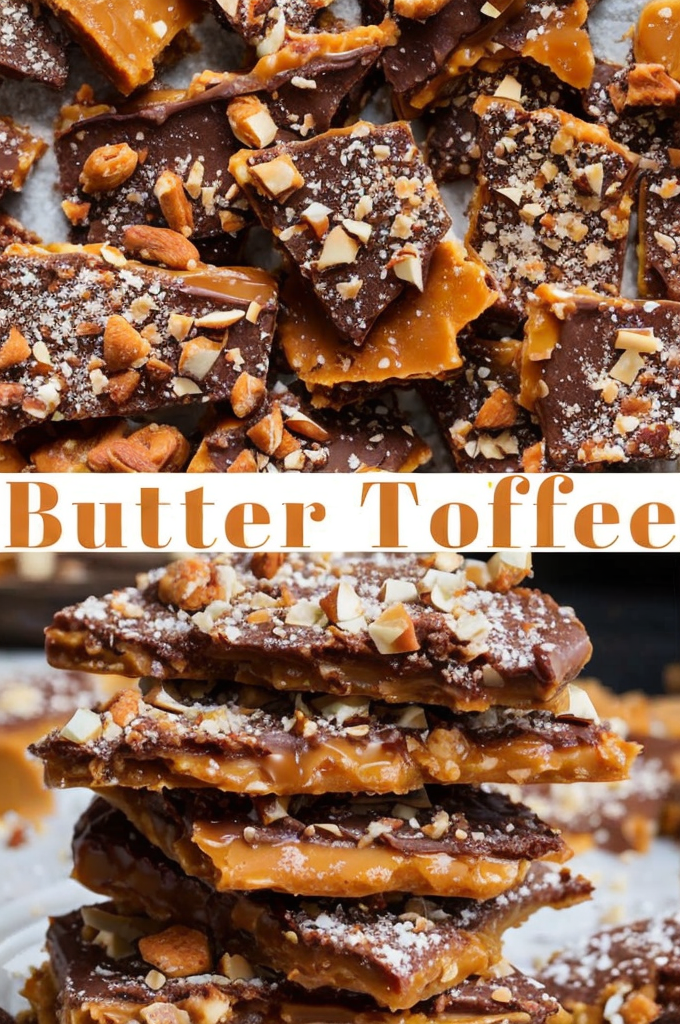Easy Homemade Toffee Recipe – Ready in 30 Minutes: A Sweet Delight for All Occasions
Toffee is a delightful sweet treat that’s surprisingly easy to make at home. This easy homemade toffee recipe delivers rich, buttery flavor with just the right amount of sweetness, making it a perfect snack or dessert for any occasion. Ready in just 30 minutes, you can indulge in homemade confectionery goodness with minimal effort. Whether you’re a seasoned cook or just starting out, this recipe demystifies toffee making, guiding you step-by-step to caramelized bliss.
The appeal of this homemade toffee extends beyond its mouthwatering taste. As you break into each piece, you’ll discover a delightful crunch followed by a luscious, buttery melt-in-your-mouth experience. The combination of sugar and butter creates an irresistible aroma that fills your kitchen, making your home feel warm and inviting. With its beautiful golden hue, this toffee also makes for a visually pleasing treat. Packaged in decorative boxes, it can serve as an excellent homemade gift for friends and family.
Quick Recipe Highlights
- Flavor Profile: Sweet and buttery with a hint of caramel, giving it a rich, layered taste.
- Texture: Firm yet slightly chewy ensures a pleasant crunch with each bite.
- Aroma: Caramelized sugar and rich butter create an enticing waft as it cooks.
- Visual Appeal: Golden, glossy sheen highlighted by optional nut topping.
- Skill Level Needed: Basic cooking skills are sufficient; follow the instructions carefully.
- Special Equipment: Heavy-bottomed saucepan, candy thermometer, and baking sheet.
Recipe Overview
- Difficulty Level: This easy homemade toffee recipe is suitable for beginners. The main challenge lies in not overcooking the sugar, which can be managed by keeping a close eye on the thermometer.
- Category: Desserts and Sweet Treats; ideal for after-meal indulgence or special treats.
- Cuisine: While toffee has its roots in English confectioneries, its widespread appeal makes it a favorite worldwide.
- Cost: Relatively inexpensive as it primarily uses pantry staples like sugar and butter.
- Season: Perfect for any season, although it’s especially popular during the fall and winter holidays.
- Occasion: Great for gifting, holiday celebrations, or a sweet personal indulgence.
Why You’ll Love This Recipe
The delightful blend of sugar and butter in this easy homemade toffee creates a sumptuous treat that’s hard to resist. The balance of sweetness and a hint of salt elevates its taste, making each bite a memorable experience. The texture offers a satisfying crunch that pleases the palate and engages the senses. It doesn’t require extensive baking skills, and the ingredient list is short, ensuring an effortless preparation process. Perfect for busy schedules, the recipe’s quick turnaround lets you whip up a batch anytime a sweet craving strikes.
From a nutritional perspective, homemade toffee allows you to control sugar intake and portion sizes, making it a relatively guilt-free indulgence. When shared with friends or at parties, it becomes a conversation starter and a crowd favorite, often mused upon for its irresistible taste. Economically, it offers excellent value, with each batch yielding several servings of premium quality toffee at a fraction of store-bought prices. Its accessibility to beginners makes it an ideal recipe for people new to confectionery challenges, opening doors to more adventurous cooking endeavors.
Historical Background and Cultural Significance
Toffee originated in England during the early 19th century, where it was primarily enjoyed by the middle and upper classes. The combination of sugar and butter was a luxurious twist on more common confections, landing it a special place in British candy history. As sugar became more affordable, toffee’s popularity surged beyond the borders, spreading its sweet influence worldwide. Over time, regional variations emerged, including different flavors and additives like nuts or chocolate, reflecting local tastes and cultural influences.
Enjoyed across generations, toffee has retained its nostalgic charm and continues to be a favorite around the world. It has become a symbol of homemade confectionery craftsmanship, often featured during holiday seasons and special occasions, signifying warmth and generosity. Different countries have adopted toffee into their culinary traditions, adding unique twists that enhance and diversify its flavor profile. From the traditional English toffee to the nutty American rendition, the evolution of toffee illustrates the adaptability and enduring appeal of this classic sweet.
Ingredient Deep Dive
The cornerstone of any toffee recipe is sugar, traditionally used in its granulated form. In the world of confections, sugar plays a vital role in achieving the desired texture and sweetness. Historically, sugar represented a symbol of wealth, which is why toffee was initially a luxury. Nowadays, its use in moderation is celebrated for its ability to transform ordinary ingredients into exceptional treats. Opt for white granulated sugar for a classic taste, or explore alternatives like brown sugar for a molasses-infused twist.
Butter, another essential toffee component, lends a rich, creamy foundation that characterizes the indulgent taste of this treat. As a dairy product, butter’s history spans centuries, appreciated for its versatility and flavor-enhancing properties. In toffee, the butter adds depth and a distinct mouthfeel, balancing sweetness with creamy undertones. When selecting butter, go for unsalted varieties to better control the final flavor profile. Proper storage of butter in a cool environment helps preserve its freshness and flavor, ensuring your toffee tastes just right.
Common Mistakes to Avoid
- Not using a candy thermometer: Ensures precise caramelization, preventing burnt toffee.
- Ignoring stirring: Consistent stirring prevents sugar from crystallizing.
- Incorrect temperature: Cook at medium-high heat; too high can burn, too low extends cooking time, affecting texture.
- Skipping the butter prep: Ensure butter is cut into cubes for even melting.
- Inadequate cooling time: Let toffee set completely for proper texture.
- Not breaking correctly: Score toffee while slightly warm to avoid uneven pieces.
- Storing in humid environments: Keep in airtight containers to retain its crunch.
- Overcrowding nuts: Spread nuts evenly, avoiding clumps that impact texture.
- Using improper pans: Opt for a heavy-bottomed saucepan for even heat distribution.
- Underestimating batch size: Follow ingredient measurements to prevent texture issues.
Essential Techniques
Caramelization is key to perfect toffee, transforming sugar’s sweetness into a complex, rich taste. Mastery involves consistent stirring and temperature monitoring with a candy thermometer, avoiding over- or under-heating. Watch for color changes from clear to golden; visual indicators assist in nailing the ideal moment to remove from heat. Achieving a glossy finish driven by apt butter integration enhances both appearance and texture, completed with timely cooling for optimal firmness.
Pro Tips for Perfect Easy Homemade Toffee
Ensure all ingredients are pre-measured and easily accessible, facilitating a smooth cooking process without interruptions. Consistency in cooking should be maintained by monitoring heat and stirring regularly, safeguarding against crystallization. Employing a candy thermometer aids in achieving precise caramelization, while observing color cues provides on-the-spot confirmation of readiness. Use parchment paper on your baking sheet for effortless cleanup and to prevent sticking, maintaining the toffee’s shiny appearance. If adding nuts, sprinkle them while the toffee is hot to ensure adherence and even distribution. When breaking the cooled toffee, score it for cleaner, uniform pieces that enhance presentation.
Variations and Adaptations
Regional twists on toffee often include diverse flavor additions, from vanilla-infused to chili-spiced variations catering to a broader spectrum of palates. Seasonal delights encompass fruit-flavored options, such as orange zest for holiday-themed toffee or lavender during spring festivities. Dietary adjustments ensure accessibility, with plant-based butters for vegan versions and sugar substitutes for low-carb alternatives. Flavor variations are achieved through adding essences or extracts, while experiments in texture can involve altering cooling methods or nut selection. Impress your guests with toffee elegantly plated with drizzles of chocolate or artistically displayed amidst festive themes.
Serving and Presentation Guide
Presenting your toffee for optimal appeal involves applying creative plating techniques, such as layering on decorative trays surrounded by complementary accompaniments like fruits or cheeses. Garnishing with a light dusting of cocoa or edible glitter enhances its visual charm, making it more enticing. Traditional accompaniments such as a classic cup of tea or coffee contrast complementary sweetness, while modern suggestions include pairing with exotic teas or cold brews. Consider serving the toffee chilled, favoring a cooler environment, to underscore its crunch and avoid over-softening.
Wine and Beverage Pairing
Toffee’s buttery texture harmonizes beautifully with sparkling wine, balancing its sweetness with an effervescent counterpoint. For non-alcoholic alternatives, robust teas with subtle tannins match well, while herbal tisanes imbue additional aromatic layers. Coffee lovers will find dark roasts complementing toffee’s caramel notes, adding depth to each bite. Ensure beverages are served slightly chilled or warmed to enhance contrast with the treat’s crisp texture. Personalize serving suggestions by selecting an array of beverage options to suit varied preferences and further elevate your toffee-tasting experience.
Storage and Shelf Life
The ideal storage for toffee is an airtight container to maintain its crunchy texture and shield it from moisture, which can render it tacky. Keep it in a cool, dry place to maximize freshness and postpone crystallization. Clear, plastic containers with airtight lids best protect its integrity, and monitoring for signs of spoilage like dampness or odd odors ensures quality is never compromised. For those keen on enjoying their toffee warm, gentle reheating in short bursts maintains its texture, while knowing it can be safely frozen extends its shelf life up to three months.
Make Ahead Strategies
Planning toffee in advance calls for a checklist approach, ensuring ingredients and tools are prepped beforehand. Chopping nuts or weighing sugar a day ahead minimizes cooking day stress, focusing entirely on the delicate balance of caramelization. Partial cooling on wire racks expedites assembly, with full freezing enabling advanced production for extended enjoyment. Implementing these strategies guarantees that the unique quality of each batch is never sacrificed for convenience and that final touches like grain sugar topping or chocolate drizzle always remain fresh.
Scaling Instructions
Scaling this toffee recipe accommodates all appetite ranges, offering guidance on reducing ingredients for smaller batches or doubling for more. Doubling requires extra vigilance to avoid batch overcrowding and uneven cook times, making the right saucepan imperative. Cooking time might extend with larger quantities; keep monitoring heat levels to ensure consistent caramelization. Storing leftovers in parchment-lined trays joined by butter paper dividers prevents fusion, accommodating larger volumes for gatherings without flavor loss.
Nutritional Deep Dive
Embarking on a thorough nutritional analysis provides insight into the indulgence each toffee bite yields. The rich, buttery quality is juxtaposed with moderate sugar levels, contributing to a satisfying macro balance of carbohydrates and fats. Vitamin intake can be augmented by custom-additions like chopped almonds while sugar substitutes offer diabetic-friendly possibilities. Exploring portion control empowers continued enjoyment minus the culpability, walking the line between indulgence and restraint with informed acuity.
Dietary Adaptations
When dietary needs arise, the versatility of toffee shines, exhibiting effortless transformations without sacrificing flavor. A gluten-free variation demands minimal alterations, as most core ingredients naturally adhere to gluten-free guidelines. Dairy-free enthusiasts might opt for plant-based butter alternatives, maintaining flavor and integrity. Vegan iterations substitute organic brown rice syrup, aligning with ethical choices and extending reach to broader audiences. Whether the objective is low-carb, ketogenic, paleo, or even low-FODMAP, adapting toffee recipes has never been more accessible or creative. The imaginative possibilities of dietary adaptations are virtually boundless.
The Recipe
Easy Homemade Toffee
Serves: 8 servings
Prep Time: 10 mins
Cook Time: 20 mins
Total Time: 30 mins
Kitchen Equipment Needed
- Heavy-bottomed saucepan
- Candy thermometer
- Baking sheet
- Parchment paper
Ingredients
- 1 cup unsalted butter
- 1 cup granulated sugar
- 1/4 teaspoon salt
- 1 teaspoon vanilla extract
- 1 cup chopped nuts (optional)
Directions
- Preheat oven to 350°F (175°C). Line a baking sheet with parchment paper.
- In a saucepan, melt butter over medium heat. Add sugar and salt, stirring constantly.
- Attach candy thermometer to the saucepan. Continue stirring until mixture reaches 300°F (149°C) or hard crack stage.
- Remove from heat and carefully stir in vanilla extract.
- If using, sprinkle nuts onto the prepared baking sheet. Pour toffee mixture over nuts.
- Let the toffee cool completely before breaking into pieces.
Recipe Notes
- For a chocolate twist, sprinkle chocolate chips over hot toffee before cooling.
- Store in an airtight container at room temperature for up to two weeks.
Troubleshooting Guide
Address common issues like achieving the right texture by ensuring temperatures are measured and matched exactly per recipe. To resolve flavor imbalances between sweet and salty, adjust seasoning post-cooking if needed. Counter temperature problems by verifying thermometer accuracy periodically. Equipment challenges, such as uneven cooking, are minimized through reliable, weighted pans and even stirring. Ingredient substitutions could involve experimenting with organic or allergen-friendly options, precision aligned with unwavering flavor. Calibrating timing prevents proximity issues that can stem from either underrating or overestimating ingredient transformations.
Recipe Success Stories
With its universal allure, this homemade toffee inspires endless stories of triumph and personalization. From peanut-studded variations for nut lovers to elegant almond-scented concoctions, everyone discovers their personalized masterpiece. Community input reveals clever techniques, such as layering different chocolate types, yielding eye-catching results. Reader discoveries inspire inventive twists that honor traditional roots while embracing modern culinary tastes, offering a treasure trove of suggestions surpassing confectionery expectations.
Frequently Asked Questions
Can I use salted butter instead of unsalted butter? While you can, it’s recommended to use unsalted butter for better taste control. Adjust the added salt accordingly if you opt for salted butter.
How do I store toffee to keep it crunchy? Store toffee in an airtight container at room temperature to maintain its texture. Avoid refrigerating as moisture can soften the toffee.
What happens if I don’t use a thermometer? Without a thermometer, the toffee may not reach the correct temperature, leading to soft or burned results. For best results, use a candy thermometer.
How do I prevent the toffee from separating during cooking? Ensure the mixture is constantly and evenly stirred during cooking, and maintain a steady temperature to prevent separation.
Can toffee be made without nuts? Absolutely! Nuts add a delightful crunch and flavor but are not essential, making the toffee adaptable to personal preferences.
Is this toffee suitable for gifting? Yes, homemade toffee makes an excellent gift when packaged in decorative tins or bags, adding a personal touch.
Can I double the toffee recipe? Doubling is possible, but requires careful attention to temperature and cooking time to ensure even results.
What are suitable flavor variations? Consider adding extracts like almond or peppermint, or top with melted chocolate for a rich twist.
Does weather affect toffee making? Yes, high humidity can affect sugar crystallization. Opt to make toffee in dry conditions to avoid issues.
Can I make this toffee vegan? Replace butter with a plant-based alternative and ensure any additional toppings align with vegan guidelines.
What type of nuts work best? Pecans, almonds, and walnuts are popular choices due to their flavor profiles and texture contributions.
How long does it take for toffee to set? Allow around 30 minutes for the toffee to cool and completely set, or speed up the process by cooling it in the refrigerator.
Additional Resources
Explore our comprehensive guides on confectionery techniques, delving into sugar work artistry and caramelization science. Discover more decadent recipes like almond brittle and salted caramel squares, expanding your sweet-making repertoire. Investigate ingredient origins to better understand sugar varieties and their personalized contributions to flavor and texture. Equipped with discerning insights, enhance your kitchen prowess with recommended tools for achieving artisan-level finesse. Seasonal adaptations beckon enthusiastic experimentation, inviting you to transform toffee into a year-round treat that reflects dynamic seasonal rhythms.
Join the Conversation
Social media platforms provide a thriving hub for shared experiences, empowering you to showcase your toffee creations through vibrant photography tips and colleague-sourced inspiration. Leaving insightful reviews contributes to the communal spirit, fostering shared improvements and creative ideas. Bond over discussions of adventurous ingredient substitutions or novel presentation styles, cementing culinary connections province fabulous array of interpretation possibilities. Whether pioneering new territory or honoring established traditions, community engagement enables myriad pathways to creative expression and sweet-sharing etiquette.



